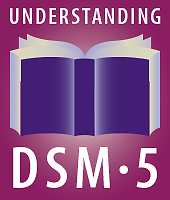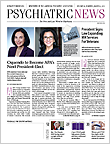A new layperson’s guide to the DSM-5 to be published in May by American Psychiatric Publishing will help patients, families, and the general public understand mental illnesses that affect people of all ages with symptoms that may cross several categories of disorders.
The book, titled Understanding Mental Disorders: Your Guide to DSM-5, covers the mental disorders in DSM-5 in clear, concise language. While it is intended for patients and their families, it will also be useful for other members of the public with an interest in psychiatric illness and how it might be affecting the people around them or for whom they are responsible—teachers, administrators, coaches, employers, and clergy, among others, will find it useful.
Like the clinicians’ version of DSM-5 released in 2013, the new guide is arranged roughly along developmental lines, reflecting a “lifespan” approach to mental illness. (See previous issues of Psychiatric News for descriptions of the chapters on disorders that start in childhood, schizophrenia and other psychotic disorders, bipolar disorders, depressive disorders, anxiety disorders, and obsessive-compulsive disorders.)
The seventh through ninth chapters cover trauma and stress disorders, dissociative disorders, and somatic-symptom disorders—illnesses that cross the lifespan and include symptoms that may present in ways similar to other disorders.
“In the area of the trauma-related disorders and dissociative disorders, Understanding Mental Disorders: Your Guide to DSM-5 offers a valuable resource for patients and families to gain an understanding of their many nuances,” said Susan Schultz, M.D., one of a six-member panel of editorial advisers who oversaw the writing and editing of the guide. “Because these categories of disorders are often seen in individuals who are also suffering other concurrent disorders, they can be especially challenging to sort out by the lay public. Persons with trauma-related illnesses or dissociative disorders commonly are also suffering from problems with mood, anxiety, and substance use, which can create difficulty in achieving the right diagnoses and care.
“This guide offers information that may permit readers to navigate to the right treatment despite suffering puzzling symptoms that seem to span many categories,” Schultz told Psychiatric News.
The new book’s description of traumatic disorders offers a sample of the straightforward, easy-to-understand language used throughout: “A traumatic event is something horrible that people have lived through or seen. It upsets, scares, and disturbs those who survive or learn about the event. Stress is a common experience and involves feeling tense or pressured. For some, major stress can lead to feeling overwhelmed and unable to cope.”
Many chapters of Understanding Mental Disorders: Your Guide to DSM-5 include an illustrative patient story, based on a real-life clinical vignette, with names and other identifying information altered. For an example, see “Mary’s and Robert’s Stories” the box describing two patients who experienced the same traumatic event but had different reactions.
Dissociative disorders, which can be especially bewildering to patients, are described like this: “Dissociative disorders cause problems in people’s normal sense of awareness and affect their sense of identity, memory, or consciousness. Dissociation is a change in awareness that alters a person’s sense of identity or self. It affects the person’s ability to connect memories and perceptions. Dissociative disorders … involve severe changes in a person’s mental state, and some can cause big gaps in memory. They can become an unhealthy way for the person to avoid reality.”
In comments to Psychiatric News, Schultz—who is president of the American Association for Geriatric Psychiatry and director of the Iowa Geriatric Education Center as well as codirector of the Center on Aging and Aging Mind and Brain Initiative—noted that changes to the chapter on somatic disorders are particularly important to older adults needing mental health services who may be prone to experiencing anxiety about medical illnesses.
(Among the most important of those changes is the removal of the centrality of medically unexplained symptoms—a defining characteristic of these somatic disorders in
DSM-IV; see
Psychiatric News, March 1, 2013).
“This new guide provides a very useful opportunity to explain the substantial changes to the somatic disorders that were developed for DSM-5,” Schultz said. “The new criteria for the somatic disorders offer a great advancement in our ability to characterize the complex patient who presents with primarily medical complaints or physical symptoms that are challenging to the clinician.The guide helps patients and families better understand these perplexing conditions that can be very distressing and lead to multiple visits to different medical specialties before they are accurately diagnosed.” ■
More information on
Understanding Mental Disorders, including pre-ordering information and links to previous articles in
Psychiatric News about the content, can be accessed
here.

